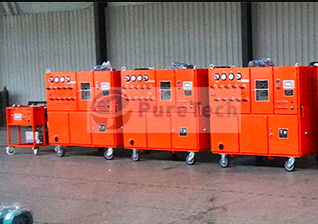SF6 Gas Recycling: Key to Sustainable and Efficient Electrical Systems

SF6 (sulfur hexafluoride) gas is widely used in electrical systems, particularly in high-voltage switchgear and circuit breakers, due to its excellent insulating and arc-extinguishing properties. However, SF6 is a potent greenhouse gas with a high global warming potential, making its recycling crucial for environmental protection. This article explores the importance SF6 gas recycling its processes, benefits, and considerations for effective implementation.
What is SF6 Gas?
SF6 is an inorganic, colorless, and odorless gas that is highly effective in insulating electrical equipment and quenching electrical arcs. Its unique properties make it an ideal choice for use in high-voltage switchgear, transformers, and other critical electrical infrastructure. Despite its advantages, SF6 is a potent greenhouse gas with a global warming potential 23,500 times greater than CO2.
The Need for SF6 Gas Recycling
Given its environmental impact, recycling SF6 gas is essential for mitigating its contribution to global warming. The gas can leak from electrical equipment during operation, maintenance, or decommissioning, leading to increased greenhouse gas emissions. SF6 gas recycling helps to minimize these emissions and ensures that the gas is reused, reducing the need for new SF6 production.
Read also: Chronoflex AL: The Biomaterial That Altered the Medical Industry for Better and for Worse
SF6 Gas Recycling Process
The recycling of SF6 gas involves several key steps to ensure that the gas is recovered, purified, and reused effectively:
- Collection and Recovery: SF6 gas is collected from electrical equipment using specialized recovery units. This process involves removing the gas from equipment that is being serviced or decommissioned and transferring it to a storage container.
- Purification: Once collected, the SF6 gas undergoes a purification process to remove contaminants such as moisture, air, and other impurities. This is typically done using filtration and drying equipment to ensure the gas meets quality standards for reuse.
- Storage: After purification, the SF6 gas is stored in high-pressure cylinders or other suitable containers. Proper storage is essential to maintain the gas’s integrity and prevent leaks.
- Reuse: The purified SF6 gas can be reused in new or existing electrical equipment. This helps reduce the need for virgin SF6 and minimizes the environmental impact associated with its production.
- Disposal: Any SF6 gas that cannot be reused or has reached the end of its lifecycle is disposed of in accordance with environmental regulations. This typically involves safely destroying the gas using specialized processes that prevent its release into the atmosphere.
Benefits of SF6 Gas Recycling
1. Environmental Protection
Recycling SF6 gas significantly reduces its impact on global warming. By reusing the gas and minimizing leaks, the recycling process helps to lower greenhouse gas emissions and protect the environment.
2. Cost Savings
Recycling SF6 gas can lead to cost savings by reducing the need for purchasing new SF6. The purification and reuse of recovered gas can be more economical than buying fresh SF6, especially in large-scale applications.
3. Compliance with Regulations
Many countries and regions have regulations and standards for managing SF6 emissions. Implementing SF6 gas recycling helps organizations comply with these regulations and avoid potential penalties.
4. Extended Equipment Life
By maintaining the quality of SF6 gas through recycling, electrical equipment can operate more efficiently and have a longer lifespan. Properly managed SF6 reduces the risk of equipment failure and enhances overall reliability.
5. Resource Conservation
Recycling SF6 gas conserves natural resources by reducing the need for new gas production. This contributes to a more sustainable approach to managing electrical equipment and infrastructure.
Considerations for Effective SF6 Gas Recycling
1. Equipment and Technology
Investing in advanced recovery, purification, and storage equipment is essential for effective SF6 gas recycling. Technology should be capable of handling the specific requirements of SF6 and ensuring high-quality results.
2. Training and Expertise
Personnel involved in SF6 gas recycling should be properly trained and knowledgeable about handling and processing SF6. This ensures safety, efficiency, and compliance with environmental regulations.
3. Safety Measures
Implementing stringent safety measures is crucial when handling SF6 gas. This includes using appropriate personal protective equipment (PPE), following proper procedures, and ensuring that recovery and recycling processes are conducted in a controlled environment.
4. Regulatory Compliance
Stay informed about local and international regulations regarding SF6 gas management. Compliance with these regulations is essential for avoiding legal issues and promoting environmental responsibility.
5. Partnering with Specialists
Working with specialized SF6 gas recycling service providers can enhance the efficiency and effectiveness of the recycling process. These experts offer valuable experience and resources to ensure proper management of SF6 gas.
Conclusion
SF6 gas recycling plays a vital role in mitigating the environmental impact of this potent greenhouse gas while ensuring the efficient operation of electrical systems. By recovering, purifying, and reusing SF6 gas, organizations can contribute to environmental protection, reduce costs, and extend the lifespan of their equipment. Implementing effective recycling practices requires investment in technology, training, safety measures, and regulatory compliance. Embracing SF6 gas recycling is a critical step towards sustainable and responsible management of electrical infrastructure.





